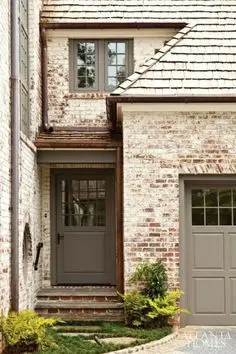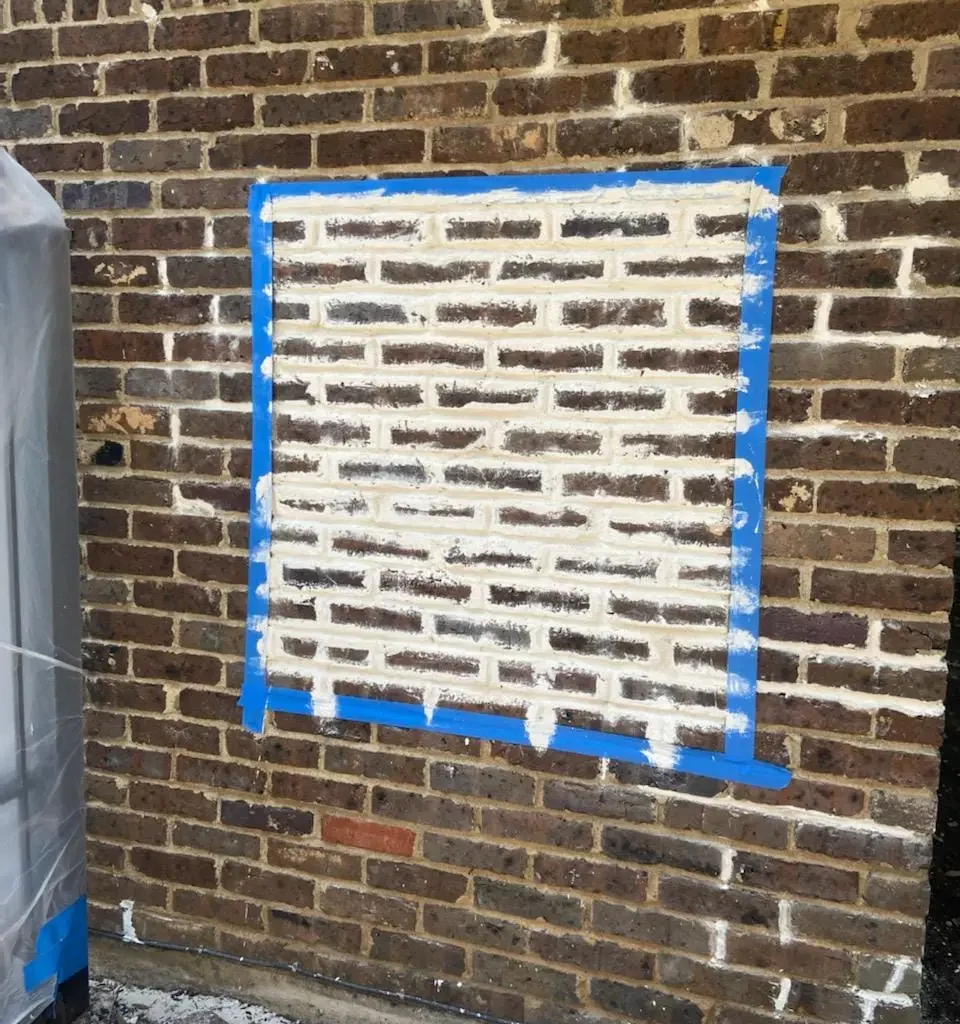German Smear Brick House: Simple Tips for a Stunning Facade
Learn how the German Smear technique can transform an outdated brick house into a trendy statement piece that stands out in any neighborhood.
The German smear technique, also known as “German schmear,” is an age-old method used to transform brick exteriors to give them a charming, rustic, and timeless appeal.
This process involves applying a mixture of mortar and water to brick surfaces. Before it dries, you wipe it off to create an antiqued, weathered look reminiscent of European cottages.
In this article, we’ll explore the ins and outs of German smear for brick homes, including its benefits and drawbacks, application tips, and design ideas to inspire your home transformation.
Why trust us? A&X Masonry was founded in 2009 and since then we’ve worked on countless German smear projects. Our master masons have decades of experience working with brick, German smear, stucco and more.
Understanding German Smear: Is It Right for Your Home?
Is German smear the right choice for your brick home?
Explanation of the Technique and How It Works
German smear is a mortar wash technique that partially covers brick surfaces, giving them an aged, distressed appearance. The process involves applying a thin layer of wet mortar over the brick and strategically removing portions before it hardens. This creates a textured, irregular finish that highlights the natural beauty of the brick while adding a layer of protection.
Unlike paint or limewash, which completely coats the surface with a thin, paint-like substance, German smear allows some of the original brick to show through next to thicker patches of mortar.
The result is a unique, organic look that varies based on application technique, mortar thickness, and drying time.

Ideal Types of Brick for German Smear
Not all bricks are suitable for German smear. You need a rough, absorbent surface for proper mortar adhesion.
Common choices include:
- Rough-textured bricks: These provide the best adhesion for the mortar.
- Red or brown bricks: The contrast between the mortar and brick creates a striking effect.
Brick types that don’t work well with German smear:
- Glazed bricks: The mortar doesn’t adhere well to the smooth, glazed surface.
Painted bricks: The layer of paint creates adhesion problems.
Considerations Before Choosing This Method
Before applying German smear to brick facades or brick fireplaces, homeowners should consider:
- Permanence: Unlike paint, German smear is almost impossible to remove once applied.
- DIY vs. Professional Application: While it’s a manageable DIY project for small areas, achieving a consistent, professional look requires skill.
- Maintenance: German smear is relatively low-maintenance but may require occasional touch-ups over time.
If you’re in the Dallas, Texas area, reach out to us at A&X Masonry to get your FREE German Smear quote. Just fill out the form on this page and we’ll get in touch.

The Basics of German Smear on Brick Technique
Materials and Tools Needed
To apply German smear, you’ll need the following materials:
- Mortar mix (typically Type N or Type S for exterior use)
- Water (to mix and adjust the consistency of the mortar)
- Bucket (for mixing the mortar)
- Trowel or putty knife (for applying the mortar)
- Sponge or cloth (to remove excess mortar and create texture)
- Protective gear (gloves, safety glasses, and a dust mask)
German Smear Application on Brick
There is no 100% correct way to do German smear. It all depends on the effect you’re going for. Here are the basics.
- Mix the mortar to a peanut butter consistency
- Spread it on the surface of the brick. Some coat the entire surface and others just coat the joints.
- Wait several minutes.
- Use a trowel or sponge to wipe it off.
IMPORTANT – Practice on a section of brick in an out-of-the-way area. Once you decide on a technique, make sure you consistently use the same technique across the entire project area.
For more detailed instructions, check out our article The Complete Guide to the German Smear Technique.

How the Process Alters the Brick’s Texture and Color
German smear creates a textured, layered effect that enhances the natural character of the brick. The thickness of the mortar application determines the final look:
- Light application: Subtle aging effect with more brick exposure.
- Medium application: Balanced texture, combining brick and mortar for a rustic look.
- Heavy application: Nearly full coverage, giving the home a classic European cottage aesthetic.
By controlling how much mortar is removed, you can customize the level of distressing to suit your desired style.
Comparing German Smear to Other Brick Treatment Methods
hen considering ways to update a brick exterior, homeowners often compare German smear to other methods such as whitewashing, limewashing, and painting. Each option has distinct characteristics:
| Method | Description | Pros | Cons |
| German Smear | Mortar partially applied and removed for a distressed look. | Long-lasting, unique texture, enhances brick character. | Permanent, requires more effort than paint. |
| Whitewash | Diluted paint applied to brick for a faded effect. | Temporary, allows some brick texture to show through. | May require reapplication over time. |
| Limewash | Made of crushed limestone and water, penetrates the brick surface. | Breathable, natural-looking, ages gracefully. | Needs periodic reapplication, limited color choices. |
| Paint | Covers the brick completely with a uniform color. | Wide color selection, easy application. | Can trap moisture, requires maintenance. |
Pros and Cons of Each Option
- German Smear: Durable and aesthetically pleasing, but permanent.
- Whitewash: Allows some brick to show through but may fade over time.
- Limewash: Eco-friendly and natural-looking but requires occasional touch-ups.
- Paint: Offers complete coverage but may peel or trap moisture.
If you decide to go with the German smear technique, how can you combine its aesthetic with the rest of your home?
Check out the next section for some ideas.
Design Ideas for Your German Smear Brick House
German smear can dramatically enhance the aesthetic of your home and complement a variety of architectural styles. Whether you want a classic, European-inspired look or a modern, rustic charm, this technique can be tailored to suit your vision.
Here are some more specific ideas.
Choosing the Right Color Palette
Selecting the right mortar color is crucial for achieving the perfect German smear aesthetic. Explore these color palette ideas to guide your choice:
- Clean and Elegant: Opt for white or off-white mortar for a fresh, timeless look.
- Softly Aged: Light gray tones create a subtle, weathered appearance, perfect for contemporary styles.
- Warm and Inviting: Beige or sand-colored mortar pairs beautifully with red and brown bricks.
- Bold and Dramatic: Charcoal or dark gray mortar adds striking contrast and depth.
Test Before Committing: Always sample your chosen mortar color on a small area of brick first.
Incorporating Landscaping and Outdoor Elements
A well-designed landscape complements the beauty of your German smear brick home and creates a cohesive outdoor space. Consider these landscaping elements:
- Soften with Greenery: Use climbing ivy or flower beds to soften the textured brick.
- Add Structured Charm: Incorporate boxwood shrubs and stone walkways for defined beauty.
- Create a Cozy Atmosphere: Wooden planters, iron trellises, and vintage lanterns add warmth.
- Embrace Modern Touches: Sleek outdoor furniture and minimalist garden designs offer contemporary appeal.
- Include Water Features: Small fountains enhance the European-inspired aesthetic.
Classic Cottage Charm
For a quintessential cozy cottage aesthetic, focus on these key elements to capture that charming style:
- Light Mortar is Key: Use light-colored mortar to achieve a soft, aged, cottage-like feel.
- Incorporate Cottage Details: Shuttered windows and wooden accents enhance the style.
- Embrace Climbing Vines: Soften the facade and add a romantic cottage touch.
- Create a Quaint Garden: Fill your garden with colorful blooms and vintage decor.
Modern Rustic Blend
Achieve a sophisticated and inviting modern rustic blend with German smear by combining contrasting elements. Consider these pairings for a balanced look:
- Neutral Mortar Foundation: Start with neutral-toned mortar as your base.
- Warm Wood Accents: Incorporate warm wood elements for natural texture and warmth.
- Industrial Touches: Introduce industrial materials like black metal and concrete.
- Sleek Lighting Choices: Opt for steel light fixtures for a modern edge.
- Minimalist Landscape Balance: Use stone or concrete planters and simple landscaping.
Elegant Lighting
Thoughtful lighting highlights the texture and depth of your German smear brick facade, especially in the evening. Here are some lighting strategy ideas:
- Create a Welcoming Ambiance: Use wrought iron sconces and vintage lanterns for warm lighting.
- Highlight Brick Texture: Uplighting pathways and walls emphasizes the rugged charm.
- Add Romantic Touches: Incorporate string lights and candle lanterns for a European feel.
- Use Warm-Toned LEDs: Choose warm LED lighting for energy efficiency and a cozy glow.

German Smear for Your Brick House - A Trendy Choice!
German smear is a timeless, versatile technique that enhances brick homes with an elegant, rustic appeal. With proper preparation and technique, you can achieve a unique, long-lasting finish that transforms your home’s exterior.
Whether you choose to DIY or hire a professional, this method offers a cost-effective and durable way to elevate curb appeal.
If you’re in the Dallas, Texas area and are interested in seeing what German Smear can do for your home, contact us today at A&X Masonry. We’re the top German Smear experts in this area and would love to give you a FREE quote on your project.
Fill out the form on this page and we’ll contact you shortly.
Frequently Asked Questions
Can German Smear Be Applied to Any Exterior Brick?
German smear works best on porous, unsealed bricks that can absorb mortar. Smooth, glazed or painted bricks may not allow the mortar to adhere well.
How Long Does German Smear Last?
German smear is highly durable and can last decades or longer with minimal maintenance. Since it bonds to the brick, it resists peeling, chipping, and fading, unlike paint.
Is Maintenance Required for a German Smear Brick Facade?
German smear requires minimal maintenance. Occasional cleaning with a gentle brush or mild detergent in soiled areas helps keep it looking fresh. Minor touch-ups may be needed if weathering occurs.
Can I German Smear My Brick Home by Myself?
We don’t recommend German smearing your brick facade by yourself if it is your first time working with this technique. Yes, German smear can be a DIY-friendly project, but achieving a professional look over a large area takes practice. Beginners should start on a small area (like a brick fireplace) before tackling the entire facade.
